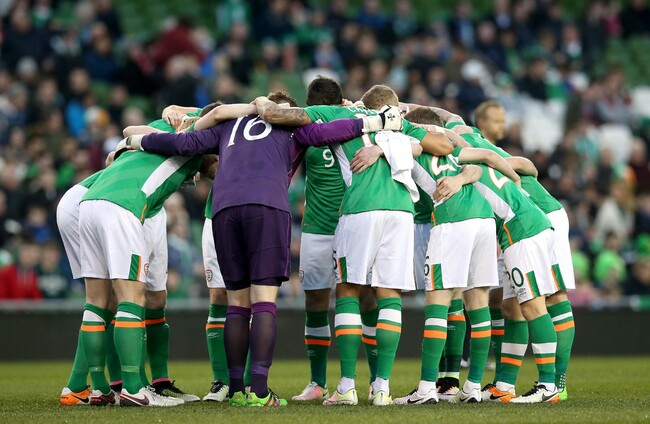MARTIN O’NEILL RAISED a few eyebrows when he opted for a diamond formation against Slovakia on Tuesday night.
Despite winning the game 1-0, O’Neill had clearly been less than satisfied with his team’s display against Switzerland on Friday.
Ireland were outnumbered by the Swiss in midfield, with David Meyler and Stephen Quinn unable to significantly influence the play going forward.
As a consequence, Ireland had just 31% possession over the 90 minutes, with their opponents’ high-pressing game, coupled with what O’Neill described as his side’s lack of confidence, ensuring passes constantly went astray and route-one football became the only logical response.
These mishaps weren’t all to do with the personnel on the pitch, and the absence of chief creator Wes Hoolahan until the final 11 minutes.
Formations
A big problem was Ireland’s struggle to cope with their opponents’ extra man in midfield, as Switzerland adopted a 4-5-1/4-3-3 formation.
The hosts’ 4-4-2 style looked ill-suited to the occasion, and brought back bad memories of Euro 2012, when then-manager Giovanni Trapattoni stubbornly stuck with this system when it clearly wasn’t working against top sides like Croatia and Spain.
After Tuesday’s match, captain John O’Shea revealed that the manager told the team an improvement was needed, saying: “The manager said ‘we need to do more tonight’ and I thought (it was better), especially in the first half, when Wes (Hoolahan) was really picking up important positions, and obviously, you had (Shane) Long-y and James (McClean) stretching them.”
There were, of course, some big changes for the Slovakian encounter. Not only did O’Neill revert to an experimental diamond formation, he also made 10 alterations to the Swiss game, most notably putting Hoolahan in the number 10 role.
Consequently, Ireland delivered a much-improved display, despite their failure to win the game, and Hoolahan was pivotal to their best moments in attack.
There was a fluidity to Ireland’s style, which meant that different players took up different positions at various points, but generally speaking, Glenn Whelan was delegated with the holding midfield role in front of the defence.
Meanwhile, ahead of the Stoke player, McCarthy was the left-sided central midfielder, with Eunan O’Kane to his right normally.
Hoolahan predominantly played in the number 10 role, but was given licence to drift out onto the flanks on occasion, as was McClean ahead of him.
Pros and cons at full-back
With wingers conspicuous by their absence, the full-backs were expected to bomb forward down the flanks, and they virtually played as auxiliary attackers at times.
Stephen Ward revealed as much in a post-match interview, explaining: “The manager changed the way we play and it gave me and Cyrus a licence to go forward.
“We’re obviously trying a few different shapes and formations, and ironing things out before the summer.”
Christie, in particular, demonstrated his prowess on the wing, and definitely benefitted from Ireland’s more adventurous approach, putting in a few good crosses during the game.
That said, as positive as much of the Irish side’s play was, it was often very risky too.
The likes of McCarthy and O’Kane, of course, often strayed from their central positions and did their bit to help out on the wings, with their discipline restricting the visitors’ pacy attackers to an extent.
Yet with Ireland having no natural wingers and the full-backs pressing on, there was still plenty of space on the flanks for Slovakia to exploit, and they duly capitalised on occasion.
There was one moment where Christie was caught badly out of position on the counter-attack, and Ireland were lucky that Miroslav Stoch’s finish was ultimately quite tame.
But Ireland were punished twice in the first half out wide, with both Slovakia goals emanating down the Boys in Green’s left side.
The first goal simply came from a poor decision by Paul McShane. The Reading captain had no need to commit himself, with Erik Sabo evading the 30-year-old defender and sprinting free down the right as a result, before his well-executed cross set up Stoch to slot home the opener.
Yet McShane’s mistake notwithstanding, it was disarming how much space the midfielder had to run into after just one simple error, which perhaps highlighted the brittleness of Ireland’s new-look system from a defensive viewpoint.
The second goal was similarly disappointing from an Irish perspective, as O’Neill’s men again looked weak down the left-hand side.
Of course, it was an excellent run forward from 29-year-old right-back Peter Pekarik, but after McCarthy initially seemed to get in a good position to break up the attack, there seemed to be a lack of communication between himself and Ward.
Both Irish players were caught flat-footed, as Pekarik found the necessary space to cross, before McShane unfortunately diverted the ball into his own net.
The two goals were by no means isolated incidents, as Ireland looked vulnerable in the full-back areas on a couple of occasions.
Consequently, this defensive weakness is one reason why O’Neill may opt against playing the diamond formation at the Euros.
The Boys in Green looked vulnerable at times the other night when the Slovaks had possession and they are hardly going to have time to rectify this problem with just two more games to play before the Euros begin.
Forward cohesion
While the defence looked suspect at times, in attack, Ireland improved considerably compared with Friday night against the Swiss.
In contrast with their previous game, the Boys in Green dominated possession — they had 58% of the ball overall.
And particularly in the first half, O’Neill’s men looked capable of doing serious damage in the final third, as the ingenuity of Hoolahan complemented the pace and physicality of Shane Long.
Hoolahan frequently received the ball in good positions, and had the confidence to turn on it, take on opponents, and thread through intricate and incisive passes.
The first goal came from some excellent high pressing, as Long won an initial challenge, before sprinting through on goal and latching on to Eunan O’Kane’s clever through pass.
It must be said that the hosts got some luck with the first penalty, which was soft at best — the Southampton man went down rather easily under goalkeeper Matus Kozacik’s innocuous challenge, before confidently converting the resulting penalty.
The build-up to Ireland’s second goal was less sophisticated and somewhat reminiscent of Long’s famous strike against Germany last October.
As on that occasion, Long latched on to Darren Randolph’s hoofed clearance, before beating the defender for pace following an excellent first touch.
And this time, it was a definite spot kick, as Martin Skrtel’s clumsy challenge clearly impeded Long. And with the Tipperary native taking a bit of a knock in the process of winning the penalty, James McClean stepped up to do the honours in his stead and put Ireland in the lead with a powerfully placed effort that eluded the goalkeeper’s grasp.
Hoolahan the difference-maker
These goals were the result of constant pressure from Ireland on the Slovak area.
Wes Hoolahan may not have been directly involved in either goal, but he was certainly inspiring Ireland to get the ball down and play, in stark contrast with the drab scenes at the Aviva on Friday night.
The below passage was a typical example of the consistently great work the Norwich star was doing in his customary number 10 position.
Yet Hoolahan’s presence from the start was by no means the only difference from Friday.
Against the Swiss, Ireland usually had a flat four-man midfield, with Aiden McGeady and Alan Judge tucked out on the wings.
But on Tuesday night, O’Neill’s deployment of all his midfielders more centrally meant they often had greater numbers in midfield than their opponents.
As a result, there were always an abundance of options for the player on the ball to choose from. O’Kane and Hoolahan both made themselves available in advanced attacking positions, whereas against the Swiss, Long and Kevin Doyle were constantly looking to run in behind the defence, thereby inviting long balls and overly ambitious passes rather than neat, intricate ball play.
Attacking unity
Notice the image below…
All 10 outfield Irish players are in shot. And the players’ close proximity to the ball is a big reason why Ireland were able to attack with fluidity all of a sudden, and this situation can be directly attributable to O’Neill’s ambitious diamond formation.
Similarly, check out the screenshot below. See how well the Irish players are pressing their opponents and count how many Irish players are visible in midfield compared with Slovakians.
If any image epitomsises why Ireland dominated possession for the most part on Tuesday, this one is it…
And so many times against Switzerland, an Irish player was forced into conceding possession because there were not enough teammates showing for the ball and making themselves available.
This problem was not a factor on Tuesday, as when an Irish player got the ball, he tended to have not one but several options on for passes.
And the fact that it was invariably Hoolahan or O’Kane receiving the ball meant it was very rarely given sloppily back to the opposition like it was against the Swiss.
But what was also impressive about the Irish performance was that it wasn’t simply focused on keeping possession for the sake of it.
The hosts were equally comfortable attempting through balls in the final third as they were at playing it along the backline.
This ambitious play consequently led to the Boys in Green opening up Slovakia — who are three places above them in the current Fifa rankings — on several occasions.
Striking changes
Inevitably, a raft of second-half substitutions meant Ireland’s momentum was promptly lost, and they struggled to regain the intensity of the first period after the break.
But while the second 45 was less entertaining than the first, it didn’t stop O’Neill engaging in a few intriguing experiments.
In the first half, Ireland’s attack was somewhat reminiscent of the way Premier League leaders Leicester play, with two fast, hard-running forwards — Shane Long and James McClean were in the Jamie Vardy and Shinji Okazaki roles at the Aviva the other night.
After the break though, Long went off, and the Boys in Green never really looked as much of a threat on the counter thereafter.
Hoolahan joined James McClean further forward, and Robbie Brady went in to the 10 role, and despite occasional glimpses of intelligent interplay between the two Norwich stars, you got the sense that Slovakia’s defence felt far more relaxed with Long off the field.
As Ireland lacked the intensity of the first half, O’Neill opted to experiment further.
McGeady replaced Hoolahan for the final 17 minutes, and the Scottish-born winger was given a similar level of freedom to roam. Nevertheless, perhaps understandably given his lack of time on the pitch, the Everton outcast failed to have the same impact as the Dubliner, who was eventually named man-of-the-match.
Anthony Pilkington was another late introduction to proceedings, but despite some nice touches, he also struggled to have an impact in his role as the makeshift striker, which allowed McClean to revert to the wing in the process.
Conclusion
Martin O’Neill will have learned plenty over the course of this latest period of internationals, not least with the respect to the strengths and weaknesses of his side’s various formations.
Owing to the dire nature of the performance against Switzerland, it seems unlikely that the Derry native will retain the 4-4-2 approach in the near future.
On the other hand, the diamond formation could be worth revisiting. It enabled Ireland to give one of their best attacking performances of the O’Neill era, with Hoolahan, Long and O’Kane all flourishing in this system.
Conversely, the hosts often appeared vulnerable on the flanks, with Ward and Christie being put under immense pressure at times from the Slovak attackers, who exploited the extra space available to them in the absence of natural wingers to protect Ireland’s full-backs.
The Irish side’s uncharacteristic defensive ineptitude (the Boys in Green conceded just eight goals in 12 Euro 2016 qualifiers) may prevent O’Neill from using this system in future, albeit in must-win games, the 64-year-old coach may be tempted to belatedly adopt this adventurous strategy.
Otherwise — despite the many positives to be taken from Tuesday night — most people will ultimately expect few differences in either style or personnel from November’s play-off games against Bosnia. So, in other words, 4-2-3-1 with McCarthy and Whelan sitting, and Hendrick, Hoolahan and Walters further forward just behind Long seems a more than likely scenario in the summer as it stands.
The42 is on Snapchat! Tap the button below on your phone to add!

















